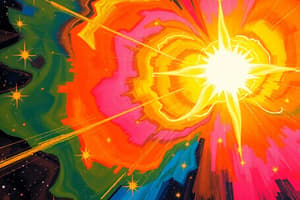Podcast
Questions and Answers
What is the primary force that holds stars together?
What is the primary force that holds stars together?
- Weak nuclear force
- Strong nuclear force
- Magnetic force
- Gravity (correct)
What determines the color of a star?
What determines the color of a star?
- Its mass
- Its density
- Its distance from Earth
- Its temperature and energy output (correct)
Which type of star would likely have a blue coloration?
Which type of star would likely have a blue coloration?
- Young, hot star (correct)
- Middle-aged yellow star
- Dying white dwarf star
- Old, red giant star
What gas is primarily burned in the core of stars to release energy?
What gas is primarily burned in the core of stars to release energy?
As stars age, what color do they tend to transition to?
As stars age, what color do they tend to transition to?
Which star example weighs more than our sun?
Which star example weighs more than our sun?
What factor determines the lifespan of a star?
What factor determines the lifespan of a star?
What triggers the release of radiation during star formation?
What triggers the release of radiation during star formation?
Flashcards are hidden until you start studying
Study Notes
Exploring the Wonders of Stars
Stars are celestial bodies that have fascinated us since the dawn of human civilization. These luminous spheres shine in the vastness of space, providing a constant flicker of light that has guided explorers, inspired artists, and fueled the curiosity of scientists. In this article, we'll delve into the fundamental aspects of stars, including their properties and the remarkable process of star formation.
Star Properties
Stars are large, dense balls of gas and plasma held together by the force of gravity. They range in size from tiny red dwarfs, which are approximately 10 percent of our sun's mass, to massive giants like VY Canis Majoris, which weighs more than 100 times our sun's mass. The burning of hydrogen in the core of stars releases energy in the form of light, heat, and radiation. This energy output is crucial to understanding how stars function and evolve.
Stars have unique colorations, which are determined by their temperature and energy output. The hottest stars emit blue light while the coolest emit red light. Our sun, for example, which is a yellow star, has a surface temperature of about 5,500 Kelvin. As stars age, they expand and cool, gradually transitioning from blue to red in color.
Stars also have a lifecycle that stretches from their birth through to their death. The life expectancy of a star depends on its size: larger stars burn through their fuel more quickly and have shorter lifespans, while smaller stars can last for billions of years.
Star Formation
The creation of stars, like the birth of new life, is a complex and mesmerizing process. Stars form within vast clouds of gas and dust called molecular clouds, which are found throughout the Milky Way. These clouds are dense and cold, containing a mixture of hydrogen, helium, and trace amounts of other elements.
Stars are born from the gravitational collapse of these molecular clouds. As the cloud contracts, its gravitational pull becomes stronger, causing the cloud to compress and heat up. As temperatures rise, hydrogen atoms combine to form molecules and ultimately release vast amounts of energy, triggering the release of radiation and the growth of a central, dense core.
In the core, hydrogen atoms fuse together to form helium, releasing energy in the process. This burst of energy provides the pressure and heat required to prevent the core from collapsing under its own weight, and the star is born.
The size of the star formed depends on the mass of the collapsing cloud. Large clouds produce large stars, while small clouds produce small stars. In some cases, a cloud may contain enough mass to form several stars, which eventually orbit each other as part of a multiple star system.
The star formation process is not complete until the new star has reached a stable state, during which it settles into its own orbit within its birth cloud and begins to emit light. This event is known as the T-Tauri phase, after the first star discovered to undergo this process.
Understanding stars requires a deep appreciation of their fundamental properties and the processes that govern their formation. By studying stars, we gain insights into the history and evolution of our universe, and explore the intricate connections that bind us to the cosmos.
Studying That Suits You
Use AI to generate personalized quizzes and flashcards to suit your learning preferences.




